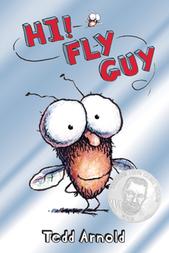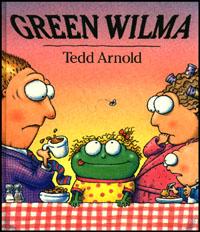
|
|
| photo: Will Arnold | |
Tedd Arnold received a Theodor Seuss Geisel Award Honor for beginning readers the first year the award was given (2006) for Hi, Fly Guy!, which introduced Buzz and Fly Guy. He earned a second in 2010 for I Spy Fly Guy! With his inaugural picture book starring the duo, A Pet for Fly Guy (Scholastic, April), Arnold demonstrates a clear understanding of the distinction between the elements of storytelling and pacing in a picture book versus the use of age-appropriate vocabulary and text-illustration balance in a book for newly independent readers. Arnold credits his wife, Carol, a kindergarten teacher with a master's in early childhood education, with helping to guide him through these developmental stages. He was born in Elmira, N.Y., where he now lives with Carol and their three cats. They have two grown sons.
Where did the idea come from, to feature a friendship between a boy and a fly?
Once, I was on a long road trip with my wife, Carol. It was her turn to drive. I was doing what I often do. I was doodling in my sketchbook, and there was one fly stuck in the car with us. It was driving us crazy. I couldn't quite reach it to shoo it out the window. So instead, I started drawing that fly. Carol and I brainstormed together about that fly until we had a story about a boy who catches a fly to take to the pet show. That brainstorming session also produced the idea that made the entire series possible. That's when I realized there's one word that Fly Guy can say, and it is the boy's name--BUZZ.
How do you create such a strong bond between Buzz and Fly Guy?
Buzz has his independent human life to live, and Fly Guy is quite independent in his fly existence. And that's the way real friendships are--people with differences and separate lives, but also a close and caring relationship. The bond comes from a mutual respect. I will never forget, after the third book in the series, Shoo, Fly Guy!, was published, a reviewer said, not in an overtly negative way but deserving of mention, that Buzz disappeared from the story near the beginning and didn't show up again until the end. I keep that comment front and center when I consider various story ideas. These aren't just Fly Guy adventures. Every story idea I pursue needs to be judged on how well it renders the relationship between Buzz and Fly Guy. These are buddy stories first and foremost.
In A Pet for Fly Guy, Buzz starts out almost in a parental role, attempting to choose pets for Fly Guy, then moves into more of a friend role, when he tells Fly Guy he must choose the right pet for himself.
I hadn't thought about the idea that Buzz was being parental, but I can see how that fits. Rather, I was simply following a path that I thought, as a child, I might take. At first Buzz simply charges ahead with his own un-thought-out ideas, then both he and Fly Guy, through a process of trial and error, begin to go beyond the obvious, and they clarify what having a pet really and truly means.
 Some of the animals from "The Amazing Pet Show" in Hi, Fly Guy! wind up in the park where Buzz and Fly Guy go pet-watching in A Pet for Fly Guy. Did you have fun returning to them?
Some of the animals from "The Amazing Pet Show" in Hi, Fly Guy! wind up in the park where Buzz and Fly Guy go pet-watching in A Pet for Fly Guy. Did you have fun returning to them?
When I first discussed the idea of a Fly Guy picture book with Scholastic, I went into it a little blind. I didn't fully realize the nuances of what might make a picture book story distinct from a series book. A couple years passed as I struggled to see beyond the series format. Finally, I went back to the first book, Hi, Fly Guy!, which was written before the series had settled into its own comfortable rhythms. I literally opened that first book and leafed through it. I lingered on the pages depicting the fanciful array of pets at the pet show, that moment when Fly Guy first became an official pet, and the idea for A Pet for Fly Guy grew from that moment.
You subtly integrate a lot of information into the search for a pet for Fly Guy, which is well-suited to the picture book audience. Fly Guy always remains true to his fly nature. Can you talk about how you thought through the character of Fly Guy?
Character-driven storylines are dictated by the characters--their strengths and weaknesses, hopes and fears, and so on. Fly Guy has his own unique abilities and a penchant for exploring gross stuff, and my readers enjoy that. He's also a very tiny guy and is easily misunderstood, and perhaps those qualities also appeal to my readers.
 We've enjoyed your signature artwork, with its myriad squiggly lines embedded in each composition. Can you tell us how you arrived at this artistic style? It seems especially well suited to Buzz and Fly Guy, with their kinetic energy.
We've enjoyed your signature artwork, with its myriad squiggly lines embedded in each composition. Can you tell us how you arrived at this artistic style? It seems especially well suited to Buzz and Fly Guy, with their kinetic energy.
I'm glad you noticed the "energy" of the scribbles. That is exactly the way I describe it. That started with an earlier book, Green Wilma, about a frog who dreamed she was a little girl. When drawing her, I put big froggy eyeballs on her. The big eyeballs required that the rest of the body had to be drawn more cartoony. Whereas before, I drew more realistically and with smooth shading, the more cartoony styling of Green Wilma caused me to actually draw faster and looser, and to scribble in the shadows. I quickly recognized how the texture added color and energy to my drawings. Now I happily tell the kids that I get paid to scribble.
Is there anything you'd want your readers to know?
Yes, it's what I say to kids at the end of each of my school presentations. "If you keep drawing, you'll get better at it. If you keep writing, you'll get better at it. If you keep reading--you'll get better at everything!" --Jennifer M. Brown

